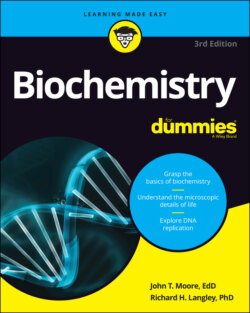Читать книгу Biochemistry For Dummies - John Moore T., Richard Langley H., John T. Moore - Страница 39
Water-related interactions: Both the lovers and the haters
ОглавлениеThe predominant factor leading to hydrophobic interactions is the presence of portions of a molecule containing only carbon and hydrogen. Hydrocarbon regions are nonpolar and are attracted to other nonpolar regions by London dispersion forces.
In general, the presence of any atom other than carbon and hydrogen makes a region polar. Oxygen and nitrogen are the most effective elements in biochemistry for making a region of a molecule polar. Sulfur is the least effective of the common biologically important elements at imparting polar character. Dipole-dipole, hydrogen bonding, and ionic interactions are all hydrophilic interactions. London dispersion forces are hydrophobic interactions. (See the section “Everybody has ‘em: Intermolecular forces,” earlier in this chapter, for the lowdown on these types of interactions.)
The more carbon and hydrogen atoms that are present without other atoms, the more important the hydrophobic nature of a region becomes in defining the molecule’s properties. A molecule may have both a hydrophilic and a hydrophobic region, and both regions are important to the molecule’s behavior. The formation of a micelle (see Chapter 2) is an example of using molecules with both hydrophilic and hydrophobic regions. Think of these micelles every time you wash dishes. The soap or detergent dissolves the grease or oil and forms a micelle, keeping the grease in solution so that it can go down the drain.
